This is an image of Olympus Mons.
Click on image for full size
NASA
Olympus Mons
The largest volcano in the solar system is Olympus Mons, shown in the image to the left. Olympus Mons is three times as high as the largest mountain on Earth, Mt. Everest, and is as wide as the entire chain of Hawaiian Islands! Measurements returned by Mars Global surveyor show the unbelievable size of Olympus Mons.
Mars has several other *very* large volcanoes. Some of them are found on top of a big bulge in the side of Mars called the Tharsis Ridge.
You might also be interested in:
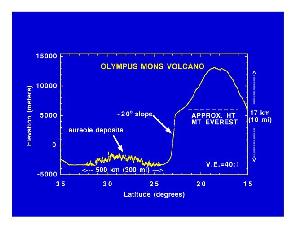
Mars Global Surveyor carries an instrument which measures the heights of things. This instrument is called an altimeter, or "altitude-meter". The graph to the left shows the results returned from Mars
...more
This drawing shows another way that islands are made. A rising hot bubble of material finds it's way into the crust of the Earth from the deep interior, and begins to erupt. This bubble or "plume" is called
...more
Mars Global Surveyor carries an instrument which measures the heights of things. The picture to the left shows the results returned from Mars Global Surveyor's measurement of the size of some of the Martian
...more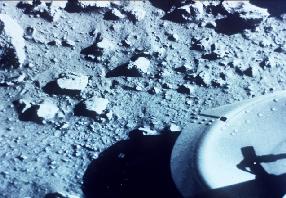
The Viking I and Viking 2 missions were to both orbit Mars and land on the planet's surface. There were two spacecraft for each mission. At this stage in the history of the exploration of Mars, scientists
...more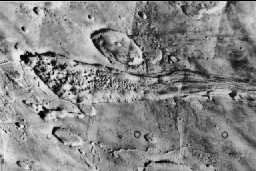
On Mars there are the remains of many tear-drop shaped lakes such as the one shown in this image. Most of these are found near the Martian volcanoes. They are really channels where water once gushed forth.
...more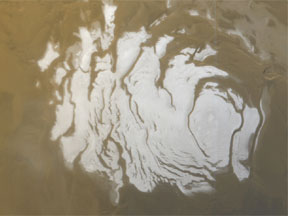
The first spacecraft to take a picture of the South Pole of Mars was Mariner 7. The South Pole of Mars has craters, sand dunes, and the polar ice cap. The south pole of Mars is important because that's
...more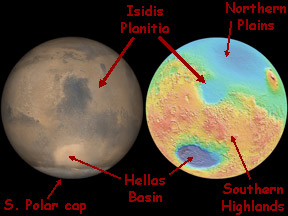
Isidis Planitia is the name of a place on Mars. Isidis Planitia is a very flat plain. It is inside the bottom of a very old crater. Isidis Planitia is big. It is about 1,500 km (930 miles) across. That
...more















